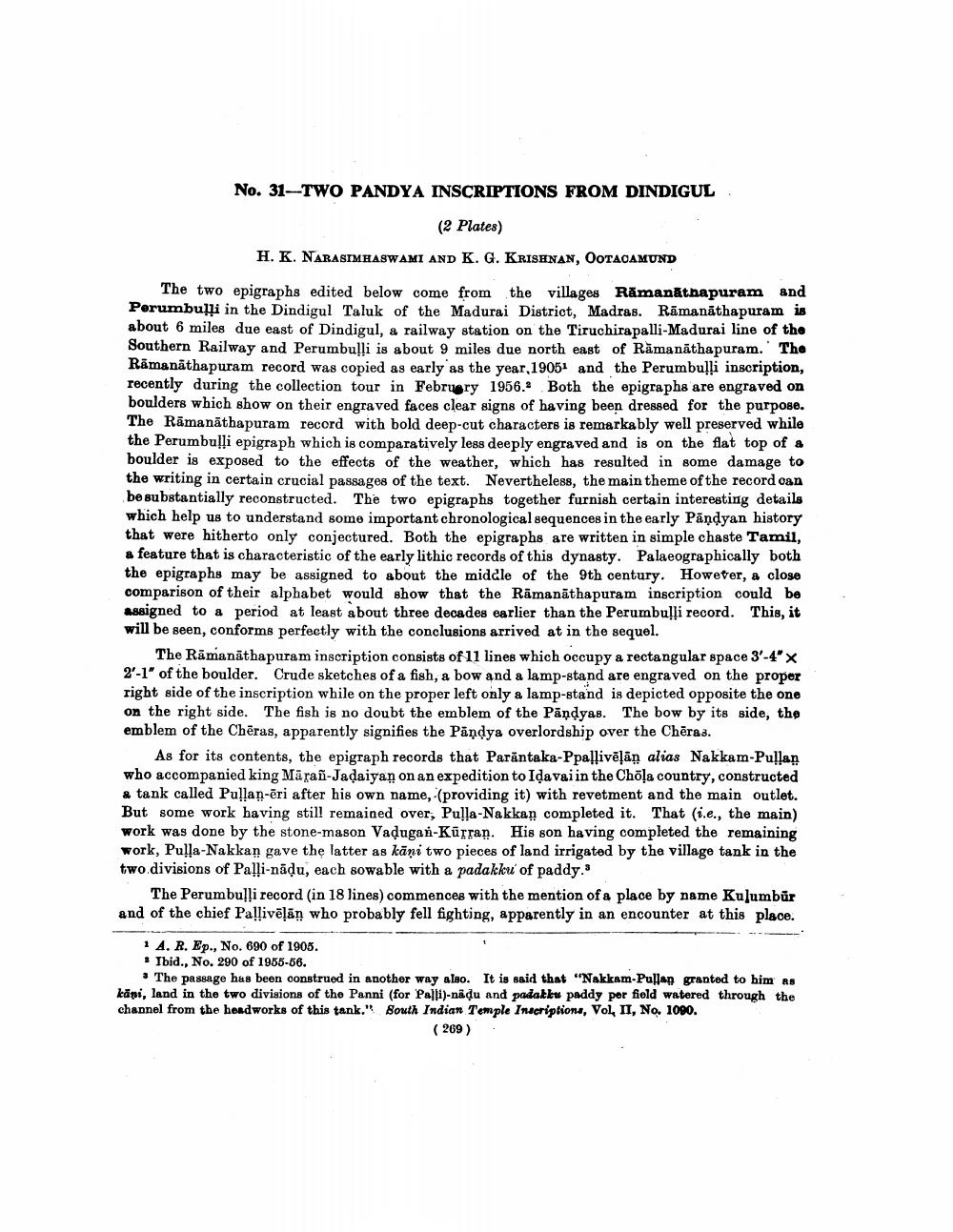________________
No. 31-TWO PANDYA INSCRIPTIONS FROM DINDIGUL
(2 Plates) H. K. NARASIMHASWAMI AND K. G. KRISHNAN, OOTACAMUND
The two epigraphs edited below come from the villages Ramanathapuram and Perumbulli in the Dindigul Taluk of the Madurai District, Madras. Rāmanāthapuram is about 6 miles due east of Dindigul, a railway station on the Tiruchirapalli-Madurai line of the Southern Railway and Perumbulli is about 9 miles due north east of Rāmanāthapuram.' The Rāmanāthapuram record was copied as early as the year, 19051 and the Perumbulli inscription, recently during the collection tour in February 1956. Both the epigraphs are engraved on boulders which show on their engraved faces clear signs of having been dressed for the purpose. The Rāmanāthapuram record with bold deep-cut characters is remarkably well preserved while the Perumbulli epigraph which is comparatively less deeply engraved and is on the flat top of a boulder is exposed to the effects of the weather, which has resulted in some damage to the writing in certain crucial passages of the text. Nevertheless, the main theme of the record can be substantially reconstructed. The two epigraphs together furnish certain interesting details which help us to understand some important chronological sequences in the early Pandyan history that were hitherto only conjectured. Both the epigraphs are written in simple chaste Tamil, a feature that is characteristic of the early lithic records of this dynasty. Palaeographically both the epigraphs may be assigned to about the middle of the 9th century. Howeter, a close comparison of their alphabet would show that the Rāmanāthapuram inscription could be assigned to a period at least about three decades earlier than the Perumbuļļi record. This, it will be seen, conforme perfectly with the conclusions arrived at in the sequel.
The Ramanathapuram inscription consists of 11 lines which occupy a rectangular space 3-4" x 2-1" of the boulder. Crude sketches of a fish, a bow and a lamp-stand are engraved on the proper right side of the inscription while on the proper left only a lamp-stand is depicted opposite the one on the right side. The fish is no doubt the emblem of the Pāņdyas. The bow by its side, the emblem of the Chēras, apparently signifies the Pāņdya overlordship over the Chēras.
As for its contents, the epigraph records that Parāntaka-Ppallivēļān alias Nakkam-Pullan who accompanied king Mārai-Jadaiyan on an expedition to Idavai in the Chõļa country, constructed a tank called Pullan-ēri after his own name, (providing it) with revetment and the main outlet. But some work having still remained over, Puļļa-Nakkan completed it. That (i.e., the main) work was done by the stone-mason Vadugan-Kūrran. His son having completed the remaining work, Pulla-Nakkan gave the latter as kāņi two pieces of land irrigated by the village tank in the two divisions of Palli-nādu, each sowable with a padakku of paddy.'
The Perumbulli record (in 18 lines) commences with the mention of a place by name Kulumbur and of the chief Pallivēļān who probably fell fighting, apparently in an encounter at this place.
14. R. Ep., No. 690 of 1905. ? Ibid., No. 290 of 1955-56.
* The passage has been construed in another way also. It is said that "Nakkam-Pullan granted to him as kāni, land in the two divisions of the Panni (for Palli)-nadu and padakku paddy por field watered through the channel from the headworks of this tank." South Indian Temple Inscriptions, Vol. II, No. 1090.
( 269 )




